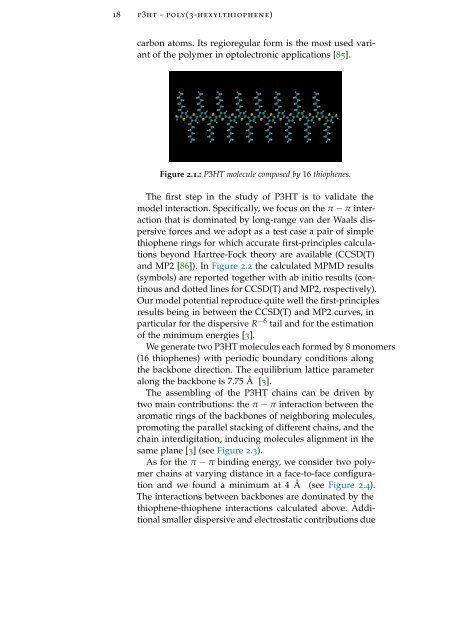Documento PDF - UniCA Eprints - Università degli studi di Cagliari.
Documento PDF - UniCA Eprints - Università degli studi di Cagliari.
Documento PDF - UniCA Eprints - Università degli studi di Cagliari.
You also want an ePaper? Increase the reach of your titles
YUMPU automatically turns print PDFs into web optimized ePapers that Google loves.
18 p3ht - poly(3-hexylthiophene)carbon atoms. Its regioregular form is the most used variantof the polymer in optolectronic applications [85].Figure 2.1.: P3HT molecule composed by 16 thiophenes.The first step in the study of P3HT is to validate themodel interaction. Specifically, we focus on the π − π interactionthat is dominated by long-range van der Waals <strong>di</strong>spersiveforces and we adopt as a test case a pair of simplethiophene rings for which accurate first-principles calculationsbeyond Hartree-Fock theory are available (CCSD(T)and MP2 [86]). In Figure 2.2 the calculated MPMD results(symbols) are reported together with ab initio results (continousand dotted lines for CCSD(T) and MP2, respectively).Our model potential reproduce quite well the first-principlesresults being in between the CCSD(T) and MP2 curves, inparticular for the <strong>di</strong>spersive R −6 tail and for the estimationof the minimum energies [3].We generate two P3HT molecules each formed by 8 monomers(16 thiophenes) with perio<strong>di</strong>c boundary con<strong>di</strong>tions alongthe backbone <strong>di</strong>rection. The equilibrium lattice parameteralong the backbone is 7.75 Å [3].The assembling of the P3HT chains can be driven bytwo main contributions: the π − π interaction between thearomatic rings of the backbones of neighboring molecules,promoting the parallel stacking of <strong>di</strong>fferent chains, and thechain inter<strong>di</strong>gitation, inducing molecules alignment in thesame plane [3] (see Figure 2.3).As for the π − π bin<strong>di</strong>ng energy, we consider two polymerchains at varying <strong>di</strong>stance in a face-to-face configurationand we found a minimum at 4 Å (see Figure 2.4).The interactions between backbones are dominated by thethiophene-thiophene interactions calculated above. Ad<strong>di</strong>tionalsmaller <strong>di</strong>spersive and electrostatic contributions due
















